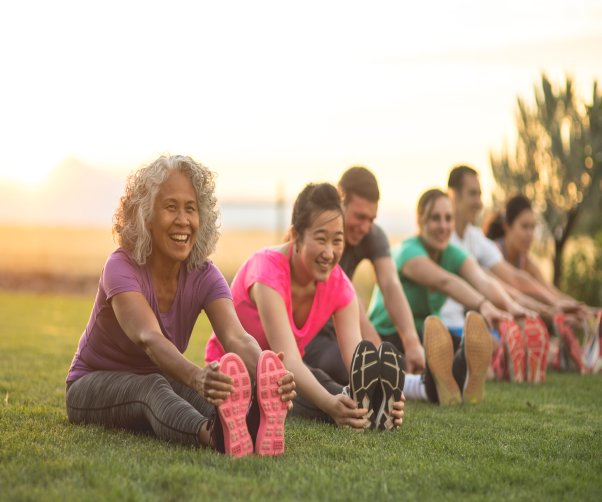
Stretch Smarter: The Key to Injury-Free Warm Weather Workouts
Ever jump into a workout on a hot day and feel stiff or sluggish? Or finish a run only to wake up the next morning feeling tighter than you should? The secret to avoiding those aches, pains and potential injuries is simple: stretching.
Stretching before and after your workout is always important, but in warm weather, it’s even more crucial. When temperatures rise, your body’s natural response is to loosen up—but without proper stretching, you could still be putting yourself at risk for strains, stiffness, muscle imbalances and heat-related issues.
At Healthier 901, we’re committed to helping you feel your best, whether you’re lacing up for a jog, hitting the gym or just staying active outdoors. Understanding how stretching enhances your workout can make a real difference—not just in how you feel afterward but in how well you perform and recover in the long run.
Core benefits of stretching
Stretching isn’t just about touching your toes or pulling your arm across your chest—it’s about setting your body up for success. Regular stretching is essential to any exercise routine, as it:
Increases flexibility and range of motion, reducing the risk of sprains, strains and injuries from overuse
- Improves circulation and muscle recovery, reducing post-workout soreness and speeding up muscle repair
- Enhances overall athletic performance, keeping muscles loose and more mobile for greater efficiency, power and endurance
“Stretching is one of the easiest and most effective ways to protect your muscles and joints, especially in warm weather when your body is already working hard to regulate temperature. Higher temps allow muscles to relax and lengthen more easily, but they can also lead to quicker dehydration and fatigue. Proper stretching keeps muscles pliable, promotes better circulation and reduces the risk of overheating—key factors for safe and effective exercise.”
– Farra Hych, director of Rehabilitation Services with Methodist Le Bonheur Healthcare
How to stretch smarter in warm weather
As a bonus for beginners, your muscles naturally relax faster in hot conditions, making it easier to stretch. Here are some key stretching strategies to consider during hotter months:
Before your workout, prepare your body
- Hydrate first. Dehydration can cause muscle cramps and stiffness, so drink plenty of water before you start to prevent cramping and fatigue.
- Start with dynamic stretching. Instead of holding a stretch for 30 seconds, focus on active movements like leg swings, arm circles or lunges to increase blood flow and prep your muscles.
- Stretch in the shade. If possible, find a cooler spot to avoid overheating before your workout even begins.
- Focus on major muscle groups. Pay attention to areas you’ll be using most, such as hamstrings, quads, shoulders and hips.
- Ease into it! Don’t push yourself to extreme flexibility right away; let your muscles warm up gradually, especially if stretching is new to you.
After your workout, take steps to aid recovery
- Cool down first. Before stretching, walk for a few minutes to gradually lower your heart rate.
- Shift to static stretching. After your workout, transition from movement-based (dynamic) stretches to static stretches, or deep stretches held for 20-30 seconds to increase flexibility and reduce tension.
- Focus on your calves, quads and hips. These areas tend to tighten up after running, cycling or strength training.
- Work in your upper body. If you’ve been lifting weights or swimming, stretch your shoulders, arms and back, as well.
- Rehydrate and refuel. Remember to drink water and eat a protein-rich snack after your workout, as it can help support muscle recovery.
When to exercise caution
Stretching has countless benefits, but it’s important to listen to your body as you go. Overstretching or stretching incorrectly can do more harm than good.
“Avoid bouncing in your stretches, as this can cause small tears in the muscle fibers. And if you ever feel sharp pain while stretching, stop immediately—discomfort is okay, but pain is a sign you may be pushing too hard. Focus on controlled, steady movements and hold each stretch for at least 30 seconds when cooling down.”
– Farra Hych, director of Rehabilitation Services with Methodist Le Bonheur Healthcare
The final stretch
Stretching might not be the most exciting part of your workout, but it’s one of the most important. By taking a few minutes to stretch properly before and after exercise—especially in warm weather—you’ll keep your muscles flexible, reduce your risk of injury and set yourself up for long-term fitness success.
So before you hit the pavement, pool or playing field, remember: a little stretch goes a long way!
Check out Healthier 901’s resources for more expert tips on staying active and injury-free all year long. And remember: when it comes to stretching, don’t sweat it—just do it!
Related Articles


